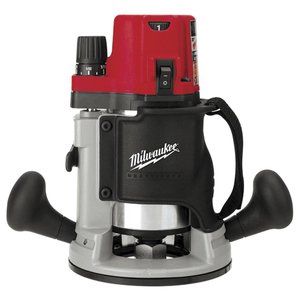
For a long time, routers have been helping woodworkers cut, trim, and shape wood, plastic, and several other materials. If you’re currently in the market for routers, tons of options range from basic to advanced. Whether it is your first, you are looking to upgrade your existing equipment, or you need the latest version to complete a different job, there is a router out there. This guide looks at several types of routers and the many router features available to improve your woodworking capabilities.
Addressing Your Router Needs
It is essential to determine your needs before deciding on the model you want and even reviewing a router comparison to look at different models. Knowing precisely what you want it to do for you is paramount.
Function

The primary function of your new router is an essential factor. If you want a tool to help you soften edges or cut a small profile, your best choice could be a primary, low-cost router. However, suppose you need your router to perform more advanced tasks like cutting more extensive profiles, dovetailing, or working with significant bits for raised panel doors. In that case, you may need a full-size router with extra features.
Budget
In addition to your woodworking needs, any router buying guide should advise you to consider the price range. Cost directly corresponds with the type of router and features offered, ranging from a primary, low-cost router to a full-size option with advanced features and a higher price tag. Conveniently, there are options with interchangeable bases that complete a wide range of tasks and router kits, which include everything from multiple bases to bits and more.
Different Types of Routers
The router’s base is the most important detail when considering your options. There are two types of bases: fixed or plunged.
Router Base: Fixed vs Plunge

Fixed routers provide an all-purpose tool for woodworkers who need to do more edging and shaping. This type is also more convenient if you are using a router table. They tend to be more compact and more accessible to operate, which allows the user to be more precise. Many fixed-base models also have a handle placement that is easier to use. If you intend to use your new tool for deeper cuts into workpieces, a fixed router must be tilted, which could lead to less precise cutting. A plunge router could be your best option for this type of cutting.
Plunge routers allow you to work on the interior by “plunging” more deeply into your materials. Providing you with controlled vertical movement, they will enable you to make deeper grooves, mortises, and more, as well as precise through cuts, patterns, and template work. A fixed base is set at a certain depth and remains there throughout use, while a plunge base allows you to change depths as you work. Choose an interchangeable base to double your tool’s versatility if you require both bases.
Router Type Comparison
Base Type |
Usage Examples |
Specifications |
Primary Benefits |
| Fixed |
|
|
|
| Plunged |
|
|
|
| Interchangeable | (see Fixed/Plunge) |
|
|
Power
Another important consideration when performing a router comparison is the power they operate with. Each model has a peak horsepower and a sustained horsepower. Peak horsepower is the highest power at which the tool operates for a brief time, while sustained horsepower is the power it operates with throughout use. Power ranges from the primary router at around 1 HP to more powerful models with up to 3.5 HP. A lower horsepower will suffice if your routing needs are simple edging tasks.
Higher horsepower serves you well to tackle a more significant, more extensive job, such as using a jig to create dovetail joinery or significant plunge cuts. Depending on the size of the bit you plan to work with, you may need more power to drive them through. When choosing a router, look at the amp rating to identify true power potential.
Desired Features
The number of features available on top-rated routers may be overwhelming, but each has the potential to improve your results. The difference in performance with one or all these options is significant, and some may even improve workshop safety.
Variable Speed Control

Variable speed control lets you choose the speed with which your router operates, depending on the task and the bit size. This is paramount when working with more significant bits, as operating slower for safety and leaving you with more control over the tool is paramount. Many mid-tier and full-size models have this option. Some top-rated routers even offer an electronic feedback system, which controls the speed based on the load it senses and ensures the RPM remains in the correct range.
Soft Start
The soft start option is one of the routers’ features related to safety. This function causes the tool to increase its speed and power output when powered on slowly. If a tool does not have a smooth start, it immediately goes to full speed, which could cause it to lurch, resulting in injury or damage to your work. Due to their added safety, soft start systems are prevalent.
Bit Change System
All types of routers have a specific system to change out bits. A tool-less bit-changing system makes the process more manageable if you alternate bits often. You also have the option of a spindle lock system, which allows single-wrench bit changes.
Motor Housing: Metal vs. Plastic
The motor housing is usually made with either metal or plastic. When operating at peak horsepower and for extended amounts of time, metal housings stand up to wear and tear, increasing durability. With plastic housings, durability, and strength may be lessened, but the tool is lighter and easier to handle. If portability and ease of use are essential, a plastic motor housing may be preferred.
Handle Design

The handle design is among the essential router features in terms of comfort. There are several types of handle placements, shapes, and sizes. Plunge router handles, for instance, tend to be higher to provide proper leverage when making deeper cuts in your materials. “D-handle” options allow two-handed control and the ability to power the tool on and off without removing either hand. The base sometimes influences handle design, but there are styles for different personal preferences and jobs.
Cord Length/Port Functionality
It would be best if you also considered the length and functionality of the tool’s power cord. Consider how close you must be to a power outlet or other source. In addition to length, the cord’s port has assorted styles and features. For example, the port could be angled or operated with a swivel mechanism to avoid tangling and accidental damage.
Conclusion
Whether you are an occasional woodworker needing tools for simple edging or a full-size router for more challenging tasks, deeper cuts, and intricate patterns, we have covered you with an extensive collection featuring several types of routers. Instantly upgrade your woodworking capabilities with features ranging from basic to advanced.




